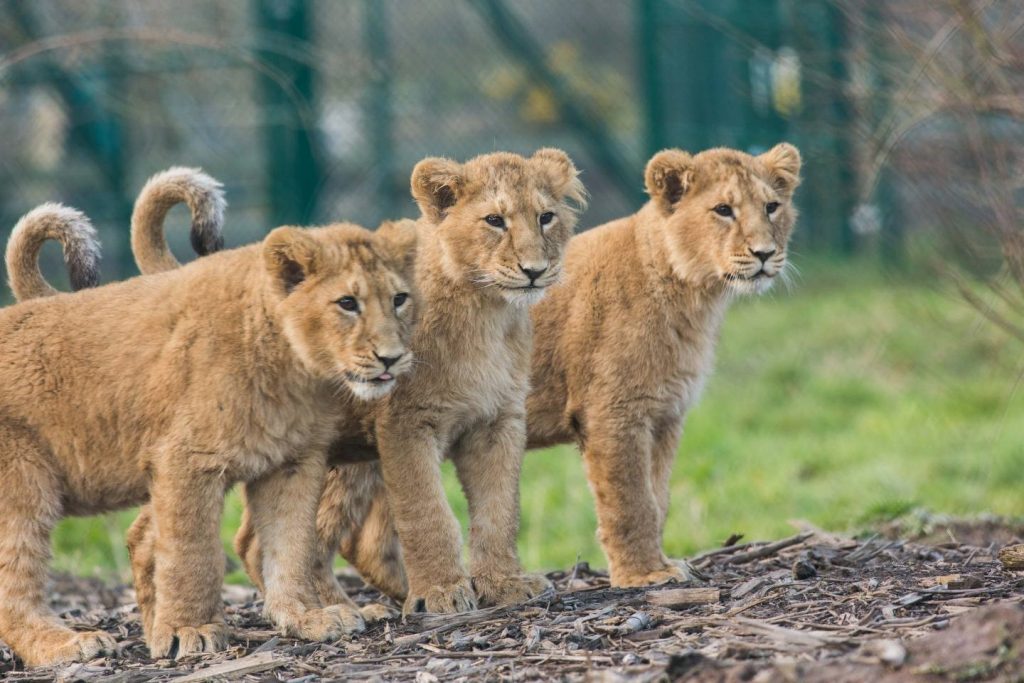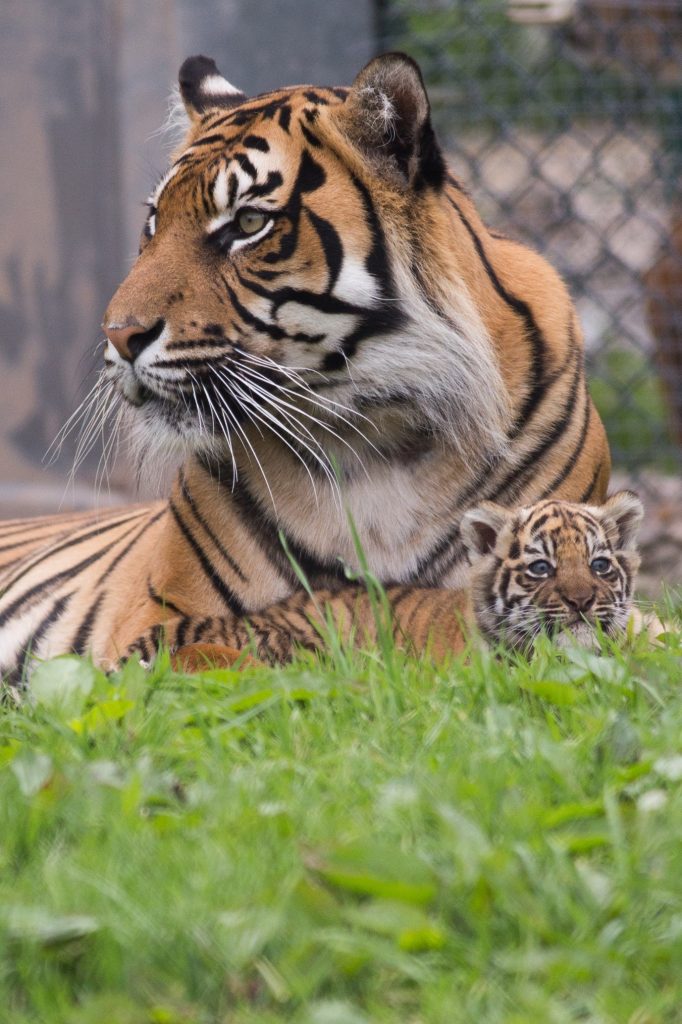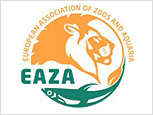Fota Wildlife Park partakes in cooperative breeding programmes, which are an essential safeguard against severe declines in the wild population, as well as contributing financially to conservation projects in the wild.

The world’s big cat populations are declining at alarming rates due to loss of habitat and prey, conflicts with people, poaching and illegal trade. The scale of the problem is distressing, for example in the last 100 years Asia’s wild tiger range has shrunk by 93% and 40% of that happened in the past ten years (21stcenturytiger.org).
Asiatic Lions
Three Asian lion cubs were born in the wildlife park last August to first time parents, mother Gira and father Shanto. After asking the public for suggestions for names the three cubs were called Amira, Ayra and Loki and have since become visitor favourites at the wildlife park. Asian lions are considered endangered by the IUCN as there are only about 500 individuals remaining in the wild.
It was Fota Wildlife Park’s first participation in the international breeding programme for Asian lions and the arrival of the cubs was an exciting time at the wildlife park. At the news of the birth, our director Sean McKeown said; “There are only approximately 200 Asian lions in Wildlife Parks and Zoos and to be able to contribute to a successful captive breeding programme worldwide is an essential safeguard against a severe decline to the wild population, which may be vulnerable to disease or other factors such as natural disaster – and the birth of the cubs is a great way of creating awareness for these conservation issues”.
The Asian lion population has recovered from the brink of extinction to several hundred individuals. Today they only live in the Gir Forest, India, which remains the stronghold for this species apart from a few prides living outside this protected area. The lions live closely alongside humans in their last remaining natural habitat, including the Maldhari community, who also live within the Gir Forest.
Speaking as to how the cubs are and how the lions are getting on as a pride, Lead Ranger Kelly said the cubs, ‘are growing fantastically, the pride actually become a really nice unit. The cubs are interacting with aunt Gita and dad Shanto really well.’
Kelly talks about how first-time mother, Gira is getting on: “She’s actually fantastic, in the last while she has been taking a little break from them and she’ll be sitting just a little bit more separate, so they’re starting to get just that little bit more grown up. Whereas before she was constantly knowing where they were, now she’s giving them a little bit of freedom and she’s comfortable with them being with Gita and dad. She’s doing a great job.”
Father, Shanto, has also ‘been a really good dad’ Kelly tells us that the cubs “climb all over him, they jump on him and he’s more than happy to let them. He will occasionally steal a bit of food from them if he decides he wants to, but that is a very natural behavior, you know, dad eats first naturally so that’s not a problem and any visitor can see, the cubs are well fed.”

The Asian lion population has recovered from the brink of extinction to several hundred individuals. Today they only live in the Gir Forest, India, which remains the stronghold for this species apart from a few prides living outside this protected area. The lions live closely alongside humans in their last remaining natural habitat, including the Maldhari community, who also live within the Gir Forest.
Speaking as to how the cubs are and how the lions are getting on as a pride, Lead Ranger Kelly said the cubs, ‘are growing fantastically, the pride actually become a really nice unit. The cubs are interacting with aunt Gita and dad Shanto really well.’
Kelly talks about how first-time mother, Gira is getting on: “She’s actually fantastic, in the last while she has been taking a little break from them and she’ll be sitting just a little bit more separate, so they’re starting to get just that little bit more grown up. Whereas before she was constantly knowing where they were, now she’s giving them a little bit of freedom and she’s comfortable with them being with Gita and dad. She’s doing a great job.”
Father, Shanto, has also ‘been a really good dad’ Kelly tells us that the cubs “climb all over him, they jump on him and he’s more than happy to let them. He will occasionally steal a bit of food from them if he decides he wants to, but that is a very natural behavior, you know, dad eats first naturally so that’s not a problem and any visitor can see, the cubs are well fed.”
Sumatran Tiger
Last June Fota Wildlife Park announced the birth of a female Sumatran Tiger cub which is one of the rarest subspecies of tiger in the world and was classified as critically endangered by the International Union for Conservation of Nature (IUCN) since 2008.
Sean McKeown, director of Fota Wildlife Park said at the time: “This is a landmark birth for us – apart from the fact this is the first time that a tiger has been born in Fota, but also because this subspecies is so vulnerable to extinction as there are as few as 300 to 500 individuals remaining in the wild. The Sumatran Tiger is Indonesia’s last tiger subspecies and it’s being pushed further and further towards extinction due to the devastation of their natural habitats, conflicts with humans and the deadly trade that poachers purvey. Therefore, anything we can do to contribute to the continued survival and genetic diversity of this subspecies is vitally important. The birth of this cub will help raise the profile of the plight of the Sumatran Tiger and further educate the visiting public for the need to conserve this beautiful and endangered species”.
The cub, named Dharma, became a great ambassador for her species and created a lot of excitement for the themed events in the wildlife park on ‘Tiger Day’ which raised funds and awareness for tiger conservation.

To date Fota Wildlife Park has raised over €27,000 for wild tiger conservation, sponsoring 21st Century Tiger’s poaching prevention programme in Sumatra as part of their ongoing contribution to wild tiger conservation which earned the Park a Gold Award from 21st Century Tiger, which has since joined forces with the Amur Leopard and Tiger Alliance (ALTA) to become the WildCats Conservation Alliance.
Cheetah
Five Cheetah cubs were born in the park last year including a litter of four cubs that were born in May made up of two males and two females. Fota Wildlife Park and visitors were thrilled with the birth of the four cheetah cubs, an active litter of cubs, which due to the place they were brought up by mother Nimpy visitors had a great view of them growing up over the last few months. This was the second birth this year for Nimpy, originally from France, who also gave birth to a male Okkasie at the start of 2017. Cheetah numbers are also declining and the population of Northern Cheetahs has plunged by 90% over the last 100 years, to just an estimated 250 left in the wild.
Cheetahs that have been bred in Fota Wildlife Park have been sent to many breeding centres around the world over the last 30 years as part of the endangered species programme. The involvement in such programmes helps ensure that the world’s fastest land animal does not become extinct with so few Northern Cheetahs existing in the wild, the birth of these cubs is very important for their population.
Fota Wildlife Park is also highly involved in the global Cheetah Conservation Programme and our Director Sean McKeown is the EEP (European Endangered Species Programme) Coordinator for the Northern Cheetah which includes collecting information on the status of all the Northern Cheetahs kept in EAZA zoos and parks, producing a studbook, carrying out demographical and genetic analyses, and producing a plan for the future management of the species.
Fota Wildlife Park is host to the 2018 European Association of Zoos and Aquaria (EAZA) Felid TAG conference from the 22nd to 25th March, where the threats to cat species in the wild, their conservation, the breeding and management within zoos and wildlife parks and re-introduction to the wild are the items discussed by big cat experts from EAZA accredited zoos and wildlife park’s worldwide.











